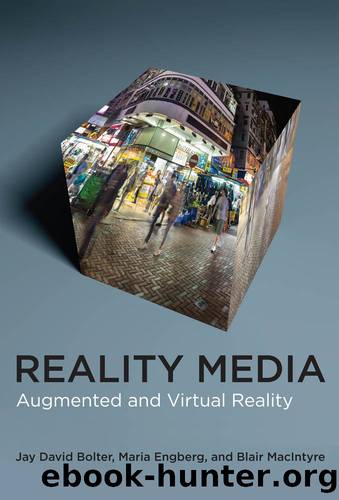Reality Media by unknow

Author:unknow
Language: eng
Format: epub
Publisher: MIT Press
Figure 6.6
Two views of a 3-D model of the Parthenon: (a) outside and (b) inside the temple. Images by Colin Freeman.
There have been many experiments with using AR overlays to bring the past into the present location (Bekele et al. 2018; Billinghurst et al. 2015). In the 1990s and 2000s, AR researchers worked to develop the techniques required to overlay images and objects exactly in a location, and they succeeded only under special conditions and with expensive technology. Although the problem is still a hard one, surface detection and image and scene recognition have now come to the consumer level of mobile devices (chapter 4), which is particularly valuable for AR applications for museums and heritage sites. In chapter 5, we discussed a prototype that allows the visitor to see a reconstruction of a building called the Middle Stoa in the Athenian agora (the marketplace located below the hill of the Acropolis where the Parthenon stood). With this geolocated AR application, the visitor could hold up the phone and see the present ruins with the Middle Stoa overlaid. These kinds of virtual reconstructions are becoming easier and more common with each new generation of mobile devices.
Paintings or objects in museums can be recognized and enhanced in various ways, although professional curators remain skeptical of anything virtual that might get between the visitor and their museum pieces. The applications of AR in remediating museum exhibits continues to grow; examples include an augmented tour at the Morgan Library in New York City; a Viking tour in the Royal Alberta Museum in Alberta, Canada; an art piece in the hanging gardens of the Pérez Art Museum Miami; and an AR experience to commemorate the moon landing at the National Air and Space Museum in Washington (Levere 2019). A Boston-based company, Cuseum, provided a particularly ingenious example of bringing back the past in the Isabella Stewart Gardner Museum in Boston, from which thirteen highly valuable paintings were stolen in 1990, including works by Rembrandt and Vermeer. The paintings have never been recovered, and the museum continues to display empty frames to commemorate the loss. In 2018, programmers at Cuseum had the idea to restore the paintings virtually. Surface detection made it possible to set two stolen Rembrandts stably in their frames without the jitter that plagued earlier AR (figure 6.7). The museum was not involved in this virtual restoration, by the way, and it was not made publicly available (Cascone 2018; Katz 2018).
All these VR and AR applications for cultural heritage and museums can be understood as remediations of earlier forms: human-guided tours, audio tours, printed museum guides, photographs, films, and even postcards made for tourists and visitors. They offer new ways to convey the aura (chapter 5) of places, artifacts, and works of art that our culture as a whole or some particular cultural community regards as special.
Download
This site does not store any files on its server. We only index and link to content provided by other sites. Please contact the content providers to delete copyright contents if any and email us, we'll remove relevant links or contents immediately.
Kathy Andrews Collection by Kathy Andrews(10551)
The remains of the day by Kazuo Ishiguro(7576)
Spare by Prince Harry The Duke of Sussex(4222)
Paper Towns by Green John(4177)
The Body: A Guide for Occupants by Bill Bryson(3815)
Be in a Treehouse by Pete Nelson(3234)
Harry Potter and the Goblet Of Fire by J.K. Rowling(3077)
Goodbye Paradise(2977)
Never by Ken Follett(2906)
Into Thin Air by Jon Krakauer(2711)
The Remains of the Day by Kazuo Ishiguro(2627)
The Genius of Japanese Carpentry by Azby Brown(2615)
The Cellar by Natasha Preston(2604)
Drawing Shortcuts: Developing Quick Drawing Skills Using Today's Technology by Leggitt Jim(2537)
120 Days of Sodom by Marquis de Sade(2446)
Architecture 101 by Nicole Bridge(2356)
Machine Learning at Scale with H2O by Gregory Keys | David Whiting(2316)
The Man Who Died Twice by Richard Osman(2307)
Industrial Automation from Scratch: A hands-on guide to using sensors, actuators, PLCs, HMIs, and SCADA to automate industrial processes by Olushola Akande(2124)
